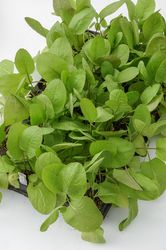 Who doesn't know horseradish? Maybe not as much as a plant, but as a root from the weekly market or the supermarket, or already processed as a white seasoning paste in a jar. (Almost) everyone knows the pungent and slightly earthy taste of this old vegetable. Or is it rather a spice? Before the widespread availability of pepper, horseradish – along with mustard – was the only hot condiment. And growing horseradish at home in your own garden is anything but difficult; moreover, growing it in a container is also possible. Horseradish young plants are now available at Lubera Edibles.
Who doesn't know horseradish? Maybe not as much as a plant, but as a root from the weekly market or the supermarket, or already processed as a white seasoning paste in a jar. (Almost) everyone knows the pungent and slightly earthy taste of this old vegetable. Or is it rather a spice? Before the widespread availability of pepper, horseradish – along with mustard – was the only hot condiment. And growing horseradish at home in your own garden is anything but difficult; moreover, growing it in a container is also possible. Horseradish young plants are now available at Lubera Edibles.
Horseradish – a short excursion into etymology and history
The horseradish (Armoracia rusticana) belongs to the cruciferous family (Brassicaceae) and is not much more closely related to the radishes of the genus "Raphanus". Even if the common name suggests it is.
In Europe, horseradish has been known since antiquity; the Greek physician and scholar Disokurides from the 1st century AD already mentions horseradish in one of his works. Furthermore, a wall painting was also discovered in the Roman city of Pompeii that clearly shows a horseradish plant. In addition, horseradish has also made it into Greek mythology. The Oracle of Delphi is said to have told the god Apollo that horseradish is worth its weight in gold.
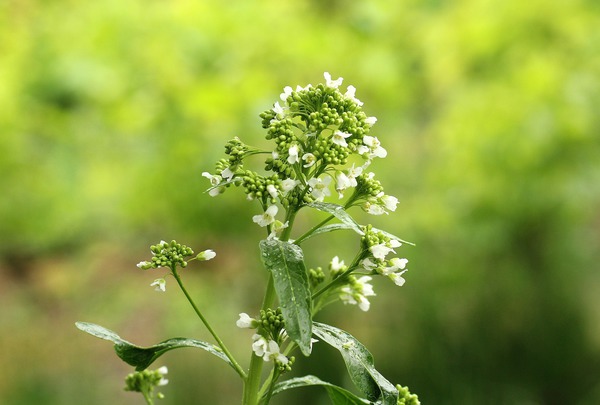
Picture: As a perennial plant, horseradish flowers very reliably. With the flowering, the affiliation to the cruciferous family (Brassicaceae) is clearly visible.
There are different opinions about the origin of the name "horseradish". However, the plant name in its Old High German form "mērrātih" can be traced back to the 10th century. According to the German botanist Heinrich Marzell, the name means "the radish that came to us across the sea". According to the etymological dictionary of the German language, it simply means "large radish" – from the Latin: raphanus major, where "major" means stronger or larger.
The name "Kren", which is common in southern Germany and Austria, goes back to a Slavic expression for "root". The original distribution area of horseradish is also assumed to be in the historical settlement area of the Slavic tribes in south-eastern Europe. The area of today's Republic of Moldova is considered to be the most secure area of origin. Due to the migration of the Slavic tribes to Central Europe, horseradish was spread throughout Europe and can be found (almost) everywhere, even wild and especially at the edge of wet meadows and along streams and rivers.
Horseradish cultivation in Germany, Europe and worldwide
The German centres of commercial horseradish cultivation are the Spreewald, the Ortenau district in Baden and the town of Baiersdorf in central Franconia. In the Franconian region, especially between Bamberg and Nuremberg, horseradish cultivation has been known since the time of Charlemagne. But horseradish is also grown agriculturally in the Hanover area, in the Hamburg area and in the Erfurt area.
In Austria, mainly in southern and eastern Styria, horseradish is cultivated on a total area of about 300 ha. In Alsace, too, there is still a noteworthy horseradish cultivation of a good 20 hectares. In addition, there is also significant horseradish cultivation in the United States, mainly in the states of Missouri, Illinois, New York and New Jersey.
Growing horseradish in the home garden
Growing horseradish in your own garden is basically anything but difficult or complicated. Due to its enormous winter hardiness and strong growth, a horseradish plant will grow (almost) anywhere. Nevertheless, there is one point that needs to be considered.
Horseradish thrives best in deep and humus-rich soil. Here it is most productive and forms highly aromatic roots. On predominantly sandy soils, the yield is also good, but the roots are less pungent and aromatic in such a location. On heavy clay soils, horseradish tends to form mostly woody roots.
Basically, there are no true varieties of horseradish, as is the case with other vegetable species. However, due to the long tradition of horseradish cultivation in certain regions of Germany, regional selections have formed, so-called "ecotypes".
As described above, horseradish often grows wild in wetter locations. This shows that a good water supply is essential for a good yield. Freshly planted horseradish plants should therefore be sufficiently watered during dry periods. This is especially true in late summer, as this is when the horseradish roots grow most vigorously.
Horseradish production in commercial cultivation
In the traditional cultivation of horseradish, the so-called root cuttings are used as horseradish young plants. These root cuttings are pieces of root with a diameter of single to double pencil thickness and have a length of 20 – 40 cm. The root cuttings are the thin extensions of the actual horseradish root and are traditionally obtained directly during the horseradish harvest. In the spring, the root cuttings are placed in the ground at a 30° angle to the surface and then covered with soil to such an extent that only the head of the root cutting protrudes from the ground. The planting can also be done using a special dibbling tool. The dibbling tool is used to pierce the oblique planting holes for the root cuttings. The angle is of particular importance in this cultivation method because it determines the success or failure of the horseradish cultivation. If the angle is too steep, a large part of the growth force goes into the foliage. If, on the other hand, the angle is too shallow, the horseradish root hardly grows in thickness.
Horseradish young plants and potted plants
If this whole procedure is too time-consuming or too labour-intensive for you, you can simply resort to pot-grown horseradish plants. Such a plant can be planted out directly in the garden, just like any other pot-produced vegetable plant. The biggest difference in this method of cultivation is not only the type of horseradish young plant used, but also the resulting crop. Horseradish young plants and young plants grown in pots, when planted out in the garden, instead of one thick root as in traditional cultivation, form several main roots that develop in parallel.
This could now be seen as a disadvantage, as the yield is not comparable with the usual commercial produce. But this difference is the real advantage of growing horseradish in the home garden. Who wants to uproot the entire horseradish plant every autumn, harvest it and replant it in the spring? The much simpler way is to regard the horseradish plant in the garden as a perennial vegetable plant that can be harvested again and again when fresh horseradish is needed – not the whole plant at once, but only root by root. For the hobby gardener, success in cultivation with a harvest quantity for personal use is usually more important than a high-performance harvest in commercial quality.
And it is precisely this kind of approach that makes for the sustainability that our EverVeg® range promises.
Horseradish as a container crop
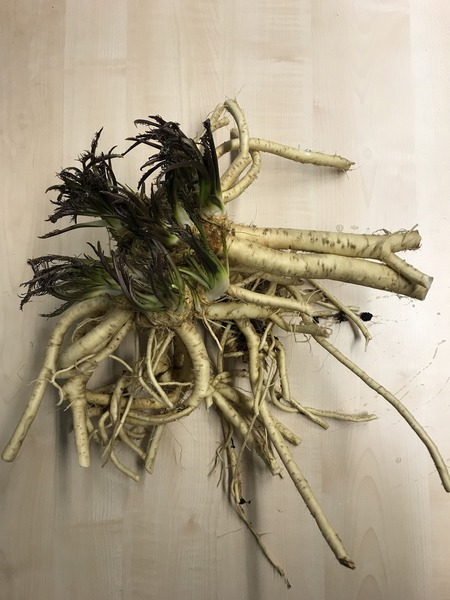
Picture: Yield behaviour of a horseradish plant grown in a pot. After one growing season, the plants were rinsed out to assess the yield.
As just described, in the home garden it is not absolutely necessary that the harvested horseradish roots have the quality of conventional commercial goods. And thus horseradish cultivation in a container is also conceivable. This also has the advantage that the horseradish cannot become independent in the home garden, as it can be propagated very well via root cuttings and reliably sprouts again from every piece of root that remains in the soil. Although horseradish in containers requires more water, it is still a good alternative, especially for smaller gardens.
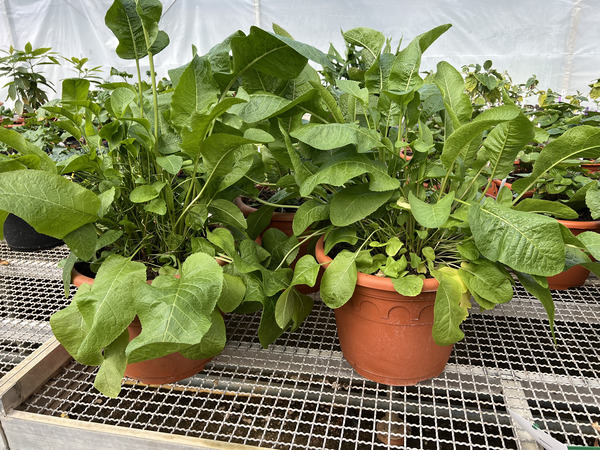
Picture: Horseradish also thrives very well in pots. The only thing to watch out for here is a good water supply.
When cultivating in containers, harvesting is done in autumn as soon as the leaves have died off by rinsing the roots with water; thin root pieces can be potted up again straight away for next year's harvest.
The Lubera Edibles horseradish young plants
The horseradish young plants are offered in standard 60-cell trays and will be available for delivery starting in calendar week 12. Our horseradish young plants are characterised by a high and consistent quality. Due to the fact that we cultivate and offer our horseradish young plants as tray plants, these horseradish young plants are virtually predestined for the cultivation of pot or container plants.
The production of horseradish plants in pots
Our horseradish young plants are available for delivery in the spring, as already mentioned, from the 12th calendar week. Due to the enormous growth performance of the horseradish young plants, you can achieve a horseradish plant ready for sale after only a few weeks of cultivation.
As with all our vegetables from the EverVeg® range, we also recommend that you produce a larger commercial plant than one that is too small. We recommend that you choose at least a 13 litre pot for our horseradish young plants, although pot sizes of up to 3 litres are also conceivable. Such a pot size raises the value of an EverVeg ® vegetable plant and therefore does not compete with the mass market of lettuce plants.
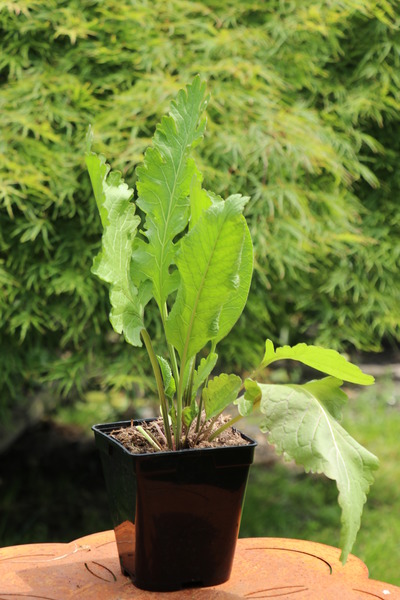
Picture: Strong horseradish plants ready for sale in a 13 cm square pot.
In addition, it is advisable not to produce only one vegetable such as horseradish young plants, but to produce and offer a self-contained assortment. For example, with other vegetable young plants from the EverVeg® range or supplemented by vegetable species from the group "Fruits of the Roots®".
Our assortment of horseradish young plants
Currently our horseradish assortment consists of one variety, the local selection 'Karl der Grosse' or 'Charlemange'. Our horseradish 'Charlemange' is very vigorous and establishes itself quickly in the garden. In the summer, the leaves can grow up to 40 cm long and they retract completely during the winter. As soon as the horseradish plant is in winter dormancy, the first roots or even the entire plant can be harvested. The roots that are left standing will then sprout again in the coming spring and form a stately plant.
Advantages of the horseradish 'Charlemagne'
- Vigorous and healthy
- Plant once – harvest for years
- Also for pot cultivation
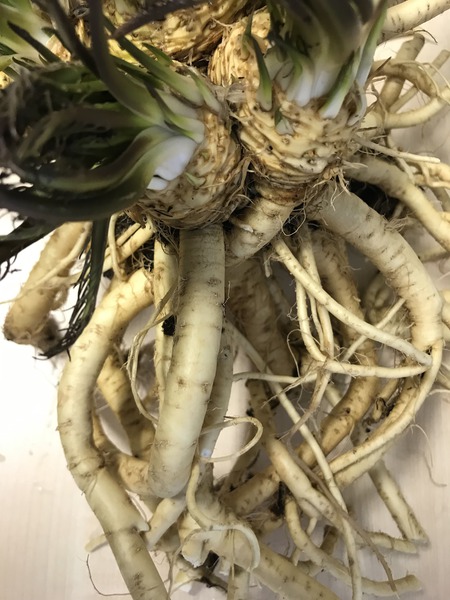
Picture: Horseradish 'Charlemagne' - a plant grown in a pot and washed out.
Short description of the horseradish 'Charlemagne'
- Growth: the plants develop strongly and the leaves can grow up to 40 cm long; the above-ground parts of the plant retract completely during the winter
- Maturity/harvest: the white roots can be harvested from mid-October onwards
- Fruits: the thick storage roots are used
- Taste: the roots have a pungent taste when freshly grated
Conclusion
As you can see, it can be well worth producing horseradish pot plants from our horseradish young plants. They can also be produced as part of a wider vegetable assortment of annual and/or perennial vegetable species. And by producing a larger sales crop, you can extend the vegetable plant season into the summer. In particular, our perennial vegetable species from the EverVeg® range are more comparable to a perennial than to an annual lettuce plant.
So it's best to take a look at our young plants online shop HERE for the horseradish young plants and order the quantity you need.
